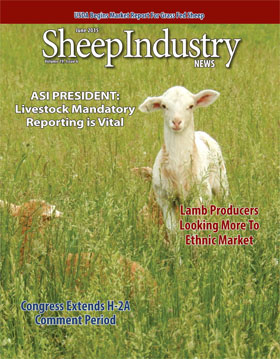
- June 2015
- President’s Notes
- Congress Extends H-2A Period
- Theos Family Reaching Niche Lamb Market
- Market Report
- Australian Wool Market Rallied; U.S. Gains
- USDA Begins Releasing Grass Fed Report
- Clark Willis Obituary
- Region IV Bighorn Plan Implemented in Utah
- Western Lawmakers Team to De-List Wolves
- ASI Photo Contest
- ASI Supports COOL For Lamb
- Battle Not Over in Sage Grouse Fight
- Livestock Mandatory Reporting
- No Grazing This Summer
- Separate Efforts: Scrapie Eradication Program and the Animal Disease Traceability Program
- Lamb Producers Look to Ethnic Groups
- Study Explores Disease in Grand Canyon Bighorns
- Sheep News In Brief
Separate Efforts: Scrapie Eradication Program and the Animal Disease Traceability Program
There has been some confusion among producers about livestock disease and tracking of livestock. Specifically, two valuable programs – the The National Scrapie Eradication Program and the The National Animal Disease Traceability Program have been misidentified.
The National Animal Disease Traceability Program went into effect in March 2013, but many producers still had ID tags based on the former system on hand. The U.S. Department of Agriculture then established a twoyear grace period to allow producers to use the old 900 or USA tags until March 11, 2015.
Animals already enrolled in a national health program, such as the National Scrapie Eradication Program or the brucellosis program for cattle, do not need an additional tag for the the National Animal Disease Traceability Program.
The National Animal Disease Traceability Program was established as a “flexible, effective animal disease traceability system for livestock moving interstate, without undue burdens for ranchers and U.S. livestock businesses,” according to the USDA. Under the rule, unless specifically exempted, livestock moved interstate would have to be officially identified and accompanied by an interstate certificate of veterinary inspection or other documentation, such as owner-shipper statements or brand certificates.
Scrapie Program
The National Scrapie Eradication Program, coordinated by the USDA’s Animal and Plant Health Inspection Service (APHIS), has reduced the prevalence of scrapie by over 85 percent.
Producers are required to follow Federal and State regulations for officially identifying their sheep and goats. Producers must also keep herd records showing what new animals were added and what animals left the herd/ flock. This guide is intended to help producers follow the regulations.
Official Identification
Official identification devices, including eartags and injectable transponders, must be approved by APHIS as being sufficiently tamper-resistant for the intended use, have good retention, and provide a unique identi¬fication number for each animal.
An owner may substitute tattooing for an official identification device under certain criteria.
Obtaining Official Tags
To request free tags or ask questions, call 1-866-USDA-TAG (873-2824). For registered herds, please provide the herd’s registration prefix and ask that it be used as your scrapie flock/herd identification number, along with your postal abbreviation.
Tags may also be purchased directly from approved tag manufacturers.
Records must be kept for 5 years after the animal is sold or otherwise disposed. Ideally, producers should keep records in an electronic format. You must record the following information:
• official identification number
• breed
• sex
• date official identification was applied
• date animal was acquired or year of birth if natural addition
• name/address of previous owner (if applicable)• date sold
• name/address of buyer

